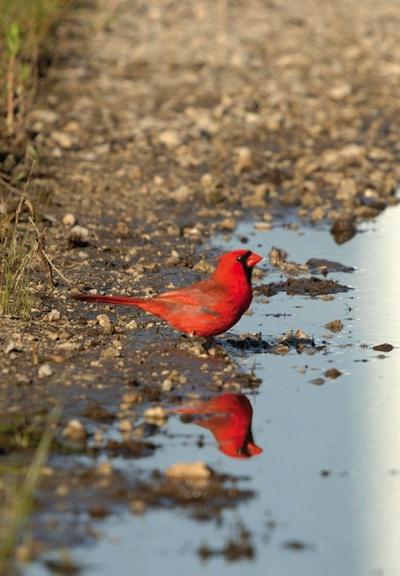
Swimmers savor the long summer days in Indiana Dunes National Lakeshore / NPS
Indiana Dunes National Lakeshore shares Lake Michigan with Sleeping Bear Dunes, which is 275 miles to the north. Indiana Dunes is a quilted landscape of sorts, interspersed as it is with industrial sites and a state park. Yet this lakeshore provides an escape to the beach and offers a cultural window into the past.
Despite the crowding of the surrounding urban environment, Indiana Dunes is a rich ecological island. Though it covers just 15 miles of beachfront, and 15,000 acres overall, the biological diversity here is among the highest in the National Park System.
Pinhook Bog, for example, is Indiana's only true bog. Here a layer of sphagnum moss floats atop an ancient lake and serves as the rooting medium for a forest. The Cowles Bog Complex is a mix of wetlands that is a small remnant of an area known as the Great Marsh, where an open body of water flowed into Lake Michigan 4,000 years ago. The bog is being restored with native plants with a goal to boost the lakeshore's biological diversity, provide a resting place for migratory birds, and create a rich outdoor classroom.

Cowles Bog can be a great birding area/NPS
You can explore the lakeshore's environment by examining glacial moraines left behind 14,000 years ago by retreating Wisconsin glaciers, fishing the Little Calumet River, or strolling through an oak forest. Tours of Pinhook Bog are possible, too, though you have to go with a ranger.
Of course, summertime beckons visitors to the beach and the cool waters of Lake Michigan. Families should consider heading to the lakeshore's West Beach, which in 2011 was recognized by Parents Magazine as one of 'America's Ten Best Beaches for Families.' Kayakers can paddle along a 15-mile stretch of the Lake Michigan Water Trail that runs between Chicago, Illinois, and Michigan City, Indiana. When completed, the water trail is expected to loop along the entire 1,600-mile coastline of Lake Michigan.
If You Go
While Lake Michigan's waters can be refreshing, they can also be dangerous. Under extreme conditions the lake can take on the appearance of a sea, with high waves and dangerous rip currents.
Though it's been more than 70 years since the 1933 World's Fair was staged, you can still tour five historic homes from that World's Fair. The Century of Progress tours in October let you see the insides of the Cypress Log Cabin, House of Tomorrow, Florida Tropical, Armco Ferro, and Wieboldt-Rostone houses. Watch the lakeshore's website for details for this year's tours.
Head to Indiana Dunes in March and you can take part in Maple Sugar Time at the historic Chellberg Farm, when the pioneer art of boiling down sap in open iron kettles over wood fires is practiced.

 Support Essential Coverage of Essential Places
Support Essential Coverage of Essential Places







Comments
Great to see some NPT props for our National Lakeshore! A few more insider tips:
+ the Pinhook Bog tours are very cool (make sure to look very closely for the carnivorous plants!) but the hours are very limited: 1-3 on Sundays only, from mid-June to mid-August. I suggest calling the park's Visitor Center to confirm, 219-395-1772. The bog is fenced and locked during non-tour hours, to protect it for research and conservation.
+ the Lakeshore's challenging Mt. Baldy dune remains closed, but the adjacent Indiana Dunes State Park (with the same terrain and lakefront exposure) is promoting the "3 Dune Challenge," where fitness buffs and wannabes can enjoy great scenery and test their mettle by hiking up the region's three tallest dunes. (I did it last week and it was quite fun.) More info here: http://www.indianadunes.com/3dc/
+ great tip on the Century of Progress Worlds Fair homes tour, but social media and other publicity has made this an increasingly tough ticket to get! The NPS opens reservations around the end of August (slight fee for shuttle transport) and they go very quickly, so be on top of this if you really want to go. Tours are offered only one day each October.
+ the hamlets of Beverly Shores (where I reside part-time) and Dune Acres are "island communities" within/on the Lakeshore, and each have train stations with service directly from downtown Chicago via the South Shore Line (70-80 minutes from Millenium Station, $8.50 or so each way), making the Dunes a great day trip away from the city. The Beverly Shores station is a very short walk from the campground for the National Lakeshore. There is another larger campground at the State Park.
+ my favorite two seasons in the Dunes are autumn and winter, with glorious (and often deserted) trails for leaf-peeping, biking, bird-watching, and even cross country skiing. Check out a sampling of Indiana Dunes National Lakeshore flora and fauna of all seasons at my photo gallery.